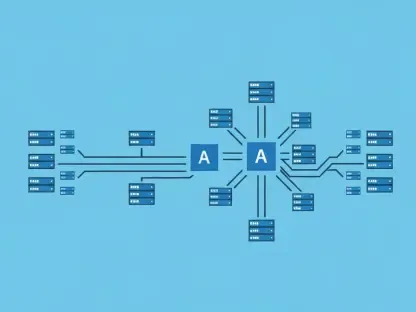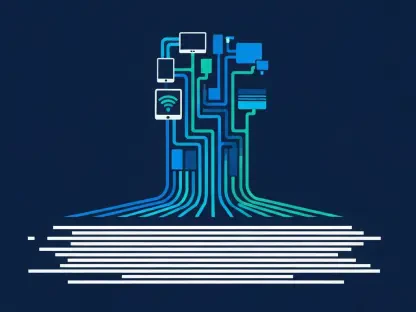Facial recognition technology has become a cornerstone in modern biometric systems, playing a crucial role in security, identity verification, and personal convenience. Amid the technological advancements, ensuring the accuracy and reliability of the underlying algorithms that measure biometric image quality has become paramount. This article dives into the intricacies of the Open Source Face Image Quality (OFIQ) project, spearheaded by the German Federal Office for Information Security, which strives to uphold these high standards.
Ensuring Algorithmic Accuracy
The quest for accuracy and reliability in facial recognition systems hinges heavily on the quality of biometric data being processed. The importance of high-quality biometric data cannot be understated, as it directly influences the effectiveness and reliability of these systems. High-quality facial images enable accurate and consistent identification, reducing the likelihood of false positives or negatives that could compromise security and trust. In this light, adherence to strict standards becomes essential, ensuring that facial recognition systems can perform dependably across various scenarios, from airport security to financial transactions.
The Importance of High-Quality Biometric Data
By setting high benchmarks for biometric data quality, initiatives like the OFIQ project address the crucial need for precision in identification processes. The impact of inferior image quality extends beyond just technical discrepancies; it can lead to significant operational challenges and security risks. Therefore, initiatives like the OFIQ project aim to maintain the highest data quality to maximize accuracy and reliability. This focus on data integrity translates into real-world benefits, ensuring that biometric systems can be trusted and widely adopted for sensitive applications. As technology continues to advance, the demand for stringent data quality standards will only intensify, making projects like OFIQ indispensable in the biometric landscape.
The ISO/IEC 29794-5 Standard
Central to the OFIQ project’s commitment to quality is its adherence to the ISO/IEC 29794-5 standard. This international standard lays out the comprehensive guidelines for evaluating facial image quality in biometric systems, providing a framework for developing and refining algorithms. The ISO/IEC 29794-5 standard is pivotal in ensuring that these algorithms meet global benchmarks for performance and reliability, fostering consistency and trust in biometric systems worldwide. Through adherence to this standard, the OFIQ project aligns itself with the highest levels of international quality assurance, positioning its algorithms to be robust and widely accepted in various applications and industries.
Developing the OFIQ Algorithms
The development of the OFIQ algorithms is a rigorous, phase-based process designed to ensure optimal performance in assessing facial image quality. The project is divided into two pivotal phases, each focusing on different aspects of algorithm development and refinement. This structured approach allows for systematic improvements, ensuring that the algorithms evolve based on empirical evidence and feedback from initial implementations. By following a phased approach, the OFIQ project ensures that its algorithms are continually enhanced, adapting to new challenges and maintaining high standards of accuracy and reliability in biometric assessments.
Phase One: Initial Implementation
In the first phase, the focus is on the initial implementation of the algorithms. These nascent versions are subjected to preliminary evaluations to gauge their effectiveness in measuring facial image quality. This phase is crucial as it sets the baseline for the subsequent refinements, identifying initial strengths and weaknesses. Evaluators measure how well the algorithms can assess various parameters of facial image quality, providing initial data points to guide further enhancements. The insights gained during this phase are invaluable, informing the iterative process that characterizes the second phase of development.
Phase Two: Refinement and Enhancement
Building on the preliminary evaluations, the second phase involves iterative refinements aimed at enhancing the accuracy and reliability of the algorithms. This phase is characterized by continuous improvement cycles, where the algorithms are repeatedly tested and adjusted based on new data and emerging challenges in the field. The focus is on ensuring that the algorithms can reliably predict the quality of biometric images under diverse conditions. Through this iterative process, the OFIQ project ensures that its algorithms remain state-of-the-art, capable of delivering high performance in real-world applications. The outcome is a set of robust, fine-tuned algorithms that can meet the stringent requirements of modern biometric systems.
Evaluation Techniques and Metrics
A critical aspect of the OFIQ project lies in its evaluation techniques and metrics, designed to comprehensively assess the performance of the algorithms. Central to this evaluation process is the establishment of rigorously labeled test sets, which serve as benchmarks for measuring the algorithms’ effectiveness. Accurate labeling of these test sets is fundamental to ensuring the validity of the evaluations, providing a reliable ground truth against which the algorithms’ predictive accuracy can be measured. This meticulous approach to evaluation underscores the OFIQ project’s commitment to empirical rigor and methodological soundness in developing high-quality biometric image assessment tools.
Establishing Ground-Truth Labels
The establishment of ground-truth labels is a cornerstone of the evaluation process. These labels represent the actual values against which the algorithms’ predictions are compared, providing a basis for assessing their accuracy. The process involves extensive manual annotation and verification to ensure that the test sets are accurate and representative of real-world conditions. Ground-truth labels are essential for validating the algorithms, as they offer an objective benchmark for performance measurement. By ensuring that these labels are meticulously created and maintained, the OFIQ project can reliably assess the effectiveness of its algorithms, driving continuous improvements and ensuring high standards of accuracy.
Empirical Cumulative Distribution Functions (ECDFs)
For numerical labels, the predictive accuracy of the algorithms is measured using empirical cumulative distribution functions (ECDFs). ECDFs are statistical tools that provide insights into how well the algorithms can predict continuous data points. By plotting the distribution of predicted values against the actual ground-truth values, ECDFs offer a clear picture of the algorithms’ performance. This method allows for a detailed assessment of accuracy, highlighting areas where the algorithms excel and identifying opportunities for improvement. ECDFs are instrumental in the OFIQ project’s iterative refinement process, offering valuable data that guides the development of more precise and reliable biometric image quality assessment tools.
Detection Error Tradeoff (DET) Curves
Binary labels, on the other hand, are evaluated through detection error tradeoff (DET) curves, which illustrate the trade-offs between false positives and negatives. DET curves are valuable tools for understanding the decision-making processes of the algorithms and their overall reliability. By analyzing these curves, developers can gain insights into how well the algorithms can distinguish between different classes, providing a basis for further refinements. The use of DET curves ensures that the algorithms can achieve a balance between sensitivity and specificity, minimizing errors and enhancing the performance of biometric systems. This comprehensive approach to evaluation underscores the integrity and rigor of the OFIQ project’s methodology.
Impact of Image Quality on Recognition Accuracy
The quality of facial images has a profound impact on the accuracy of recognition systems, necessitating rigorous assessment methods to understand and mitigate potential issues. The OFIQ project employs sophisticated metrics like error-versus-discard characteristic (EDC) curves to evaluate the influence of image quality on recognition outcomes. EDC curves provide critical data on how certain image defects impact the performance of recognition algorithms, informing refinements to improve reliability. By addressing specific image defects and assessing algorithms under diverse conditions, the OFIQ project ensures its tools are robust and capable of delivering high accuracy in real-world applications, maintaining the integrity of biometric systems.
Error-versus-Discard Characteristic (EDC) Curves
The error-versus-discard characteristic (EDC) curves are pivotal in understanding how image quality factors influence facial recognition accuracy. These curves analyze the relationship between image quality and recognition errors, indicating how certain defects can impede performance. By plotting error rates against discard thresholds, EDC curves provide a clear visualization of the impact of image quality on recognition accuracy. This analysis is critical for refining algorithms, as it highlights specific areas that need improvement. EDC curves enable the OFIQ project to identify and address weaknesses in the algorithms, ensuring that they can maintain high accuracy even when dealing with suboptimal images.
Addressing Specific Image Defects
Addressing specific image defects is an integral part of the OFIQ project’s rigorous assessment process. The project evaluates the algorithms under various conditions, simulating real-world scenarios to ensure robust performance. By systematically testing the algorithms against different types of image defects, the OFIQ project can identify potential pitfalls and develop strategies to mitigate them. This comprehensive approach enhances the algorithms’ resilience, ensuring they can handle a wide range of challenges in practical applications. The focus on addressing specific defects underscores the OFIQ project’s commitment to developing reliable and versatile biometric image quality assessment tools.
External Validation and Commercial Testing
To ensure that the OFIQ algorithms meet the highest standards, extensive external validation and commercial testing are conducted. Independent evaluations by reputable institutions like the National Institute of Standards and Technology (NIST) provide an additional layer of scrutiny, reinforcing the credibility of the algorithms. These external validations complement the internal assessments, offering an unbiased perspective on the algorithms’ performance. Moreover, by benchmarking the OFIQ algorithms against commercial quality assessment tools, the project ensures that its solutions are competitive and on par with, or superior to, those available in the market. This inclusive testing framework bolsters confidence in the OFIQ project’s methodologies and outcomes.
NIST Face Analysis Technology Evaluation
The National Institute of Standards and Technology (NIST) plays a crucial role in validating the OFIQ algorithms through its face analysis technology evaluation (FATE) Quality track. This independent evaluation process subjects the algorithms to rigorous testing, ensuring they adhere to the highest standards of performance and reliability. The involvement of NIST adds significant credibility to the OFIQ project, as it signifies that the algorithms have been scrutinized by one of the most respected institutions in the field. The insights gained from NIST evaluations help refine and enhance the algorithms, ensuring they meet global benchmarks and are suitable for wide-scale deployment in various biometric applications.
Comparing with Commercial Solutions
In addition to internal evaluations and independent validations, the OFIQ project benchmarks its algorithms against commercial quality assessment tools. This comparison is vital for ensuring that the OFIQ algorithms are competitive and can stand alongside, or even surpass, existing market solutions. By testing against commercial tools, the OFIQ project can identify areas for improvement and incorporate best practices from the industry. This inclusive testing framework ensures that the OFIQ algorithms are robust, reliable, and market-ready, capable of meeting the diverse needs of biometric systems worldwide. The ability to compare and learn from commercial solutions enhances the OFIQ project’s overall development strategy.
Broader Implications and Industry Trends
The OFIQ project’s commitment to creating standardized, open-source solutions aligns with broader industry trends prioritizing transparency and reliability in biometric assessments. As biometric systems become increasingly integrated into various sectors, the need for standardized solutions that can be trusted worldwide becomes more pressing. The OFIQ project’s methodologies cater to this demand, fostering innovation and trust in biometric technologies. Moreover, the global deployment of biometric systems, such as New Zealand’s substantial biometric upgrade and Paris’s adoption of palm vein biometrics, highlights the significance of robust image quality algorithms. These advancements underscore the global impact of high-quality biometric image assessments, reflecting the essential role of initiatives like OFIQ in shaping the future of biometric technology.
The Shift Towards Standardized Solutions
The shift towards standardized, open-source solutions is a significant trend in the biometric field, driven by the need for consistency and reliability across different applications and regions. The OFIQ project’s focus on adhering to international standards and fostering transparency sets a notable example for the industry. Standardized solutions enhance interoperability, allowing different systems to work seamlessly together, which is crucial in a globalized world. Furthermore, open-source projects like OFIQ democratize access to high-quality algorithms, enabling wider adoption and innovation. This approach not only improves the reliability of biometric systems but also builds trust among users and stakeholders, fostering a more secure and efficient technological landscape.
Global Deployments and Technological Innovations
Facial recognition technology has emerged as a cornerstone in modern biometric systems, playing pivotal roles in security, identity verification, and enhancing personal convenience. With technological advancements, ensuring the precision and dependability of the algorithms measuring biometric image quality has become essential. This article delves into the intricacies of the Open Source Face Image Quality (OFIQ) project, spearheaded by the German Federal Office for Information Security. The OFIQ project is dedicated to maintaining high standards of accuracy and reliability in biometric systems. By producing open-source tools and benchmarks, the project aims to improve the development and assessment of facial recognition algorithms. These efforts are crucial, as the integrity of biometric data directly impacts everything from airport security to smartphone authentication. As facial recognition becomes more integrated into daily life, the continual refinement of these systems ensures they remain trustworthy and efficient. Thus, the OFIQ project represents a significant step forward in the ongoing quest to perfect biometric technologies and their applications.









